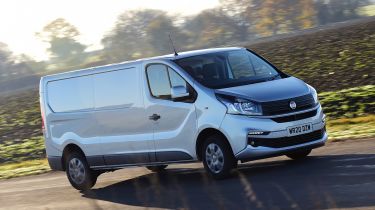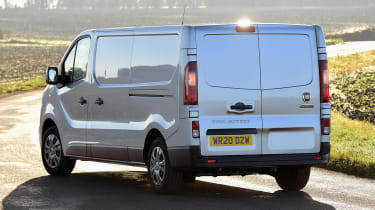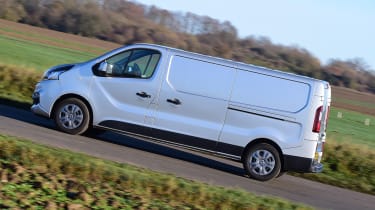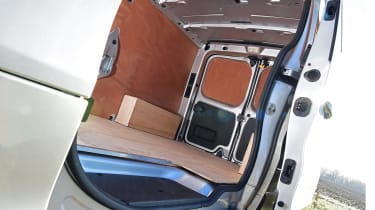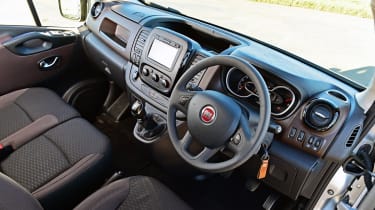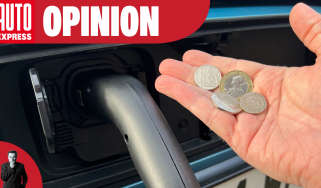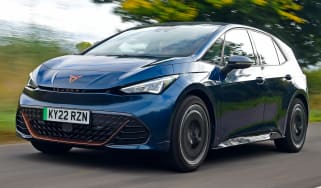Fiat Talento van review
The Fiat Talento is a strong contender in the medium-sized van sector
The Fiat Talento is a relatively new name for Fiat Professional's van for sale in the medium-sized sector. However, while the name won't be familiar, the van itself will be. Basically it’s a rebadged version of the Renault Trafic, but it's none the worse for that. Talento isn't an all-new name, either, as some may remember it being used on a short wheelbase version of the Fiat Ducato in the 1980s.
The Renault Trafic was introduced in 2014, while Fiat Professional introduced the Talento in 2016. Although it uses some platform engineering from the last Trafic, the new van has made a significant impact on the sector with its good-looking and practical design, comfortable ride and cabin refinement. The good news for Fiat fleets is that the new Talento gets the benefit of all that hard work from Renault, including its Euro 6 engines.
In fact, the only thing separating the Fiat from its Renault and Nissan NV300 sister models is the badging and grille treatment – which has been mildly reworked to reflect the Fiat Professional range’s family face, with a wide horizontal grille in place of the diamond badge seen on the Trafic.
The close ties with the Trafic and NV300 stretch as far as the location where the Fiat Talento is assembled, too, because all three are built on the same production line in Sandouville, France.
More reviews
In-depth reviews
However, with Fiat's forthcoming merger with the PSA Group on the way, the current Talento won't be around for much longer. Production of the current model is already confirmed to be wound down, and we can expect a PSA Group-derived model to arrive in 2021.
Aside from the Renault and Nissan clones, the Talento goes into battle against a tough crowd of competitors that includes the Ford Transit Custom, Mercedes Vito and Volkswagen Transporter, plus the slightly smaller but more advanced and car-like PSA Group vans, the Vauxhall Vivaro, Peugeot Expert, Citroen Dispatch and body-sharing Toyota Proace vans, which offer great packaging, an advanced safety package, and even more refinement for the driver.
The Talento comes in a variety of formats, although the range is relatively simple when compared to some rivals. There are short or long-wheelbase panel vans, plus a crew van and a chassis cab. Engine choices are limited to a single 2.0-litre Multijet diesel in 120HP or 145HP guises. We say multijet, but this is simply Renault's dCi diesel rebranded.
There are standard, SX, Tecnico and Sportivo trim levels, and all vans come with central locking, electric windows and mirrors, a height adjustable driver seat, plus Bluetooth, DAB and steering wheel controls for audio.
SX adds air-conditioning, parking sensors and an oddly named ‘Living Brown’ interior trim package, which actually gives the van a bit of a classier look inside, thanks to brown dashboard plastics and seat fabric - trust us, it adds a bit of interest to the cab. Tecnico adds some more tech and a bit more style, while Sportivo has a racier look, some leather trim and exterior graphics.
MPG, CO2 and Running Costs
One advantage the Fiat Talento has over the Renault Traffic is that it has a lower starting price. It's roughly £600-£700 less than the Renault, although there isn't as wide a variety of body styles, engines or gearboxes to choose from - the Trafic offers a high-roof variant, an auto box and a more powerful diesel where the Talento doesn't.
The 2.0-litre Multijet diesels are efficient and frugal, with Start&Stop fitted as standard across the range. Official fuel economy figures are largely the same whether you choose the 120HP or 145HP engine, with quoted figures in the 37-38mpg range.
Those economy figures look decent enough, but there’s no getting away from the fact they’re significantly down on the best in class numbers claimed by the latest Peugeot Expert and Citroen Dispatch. The PSA group rivals claim WLTP fuel economy figures in the 50mpg region.
In all significant respects the running costs for the Fiat should match those of the vans it shares a platform with, but while the Talento comes with a three-year/120,000 mile warranty, the Renault Trafic warranty is over four years, but with a 100,000-mile limit. However, Fiat Professional's Mopar aftersales division can tailor extended warranty packages to your specific needs.
Standard security features are in line with the Trafic. That means there’ll be an immobiliser on everything, but you’ll have to pay extra for an alarm. Keyless entry will be on the options list too, but all vans do get a full metal bulkhead as part of latest EU regulations.
Load Space and Practicality
The Fiat Talento’s packaging means it provides a range of very practical options. The basic van measures 4,999mm and it has a cubic capacity of 5.2 cubic metres in short wheelbase guise. Opt for the long wheelbase and capacity rises to 6 cubic metres. The space on offer means the smallest of the Talento models can swallow three Euro pallets or 11 sheets of plasterboard, and the maximum payload quoted is for a maximum of 1,249kg.
The Talento also benefits from a through-loading hatch in the bulkhead that allows you to poke longer loads like pipes or ladders through into the passenger compartment. The total available length for short wheelbase versions is 3,750mm, and 4,150mm for long wheelbase – although this CargoPlus feature is an option, and not fitted as standard. If you don’t take the option, the standard short wheelbase load length is 2,537mm. While the PSA Group vans have better running costs, they can't quite match the overall dimensions of the Talento.
It's a similar story with access, because the Talento has larger doors than the PSA models. At the back you’ll find 50:50 split barn doors that open to a wide 255-degree angle, and the left-hand door can be locked in place to show the number plate while the right can be left open if you need to hang a load out over the bumper. A big sliding side door has a 1,030mm opening – so not quite large enough for the Euro pallet.
It does have a low loading height though, at just 100mm. A plywood lining kit is optionally available with a resin-coated plywood floor, and of course any number of racking options can be explored. There are plentiful lashing points running the length of the interior on either side, too.
Reliability and Safety
The Talento has safety adequately covered, not least thanks to its sturdy construction and standard steel bulkhead. That said, Euro NCAP’s crash test of a Renault Trafic Combi in 2015 resulted in only a three star rating. In contrast, the SpaceTourer and Traveller versions of the new Citroen Dispatch and Peugeot Expert have been awarded five star ratings. The newcomers benefit greatly from sharing a platform architecture derived from a passenger car, as well as their more advanced safety systems.
In fact, the PSA duo scores 87 per cent for adult occupant safety, against 52 per cent for the Trafic/Talento, which is quite a differential. Scores for child occupant safety and pedestrian safety are similar between the rivals, but the PSA vans win out on advanced safety systems, where their 78 per cent score beats the Talento/Trafic’s 57 per cent.
Standard safety equipment on the Talento includes LED daytime running lights, ABS with EBD, and Emergency Brake Assistance plus ESC with a Traction+ function designed to enhance traction on slippery surfaces such as muddy trails. You can add optional side airbags and window airbags, plus there’s a Trailer Stability Assistance system, which adjusts braking force on each wheel to save you if your trailer gets out of shape. A reversing camera and monitor is also optional, as is cruise control with a speed limiter.
There should be no doubts over the Talento’s reliability, as the Renault-sourced engines are claimed to be good for 400,000km – and the technology is certainly tried and tested.
Driving and Performance
The latest Euro 6-compliant versions of Renault’s 2.0-litre diesel (badged Multijet in the Talento) are strong on performance as well as efficiency. Fiat doesn’t quote any performance figures, but even the 120HP engine feels gutsy, thanks to that large capacity. There’s a responsiveness to throttle, especially in the mid-range, which helps to make the Talento a pleasure to drive.
The manual gearbox is fine, if a little mushy when compared to Ford or VW transmissions, and the steering is pleasantly weighted and makes the van more accurate to place than its PSA rivals, which suffer with over-light steering. The brakes are strong, and the Fiat van feels poised and stable in corners without too much body roll. The Talento provides a comfortable ride too, with the fixed bulkhead helping to mask noise from the load bay and improving refinement.
We like the Talento’s driving position too, because there’s plenty of adjustment in both the steering column and seat. There’d be little hardship in sitting behind the wheel all day. Visibility is good, thanks to the high seat position, while large wing mirrors with a wide-angle section in the lower half mean blind spots are significantly reduced.
Cab and Interior
Here again, the Talento’s interior must play second fiddle to the more car-like ambience of the PSA group vans, but there’s not much between them from a practical perspective, and if you've sat in a Renault Trafic, again it'll look familiar. The Fiat has a two-tone plastic fascia that feels tough and solidly screwed together, and although the fit and finish doesn’t really suggest a premium feel, the Talento cabin is still a nice place to be.
There’s plenty of storage around the cabin – up to 90 litres, in fact – and there’s an optional ‘office’ facility if you order a fold-down passenger seat that converts into a table.
The seven-inch touchscreen operated sat-nav infotainment system on top-spec models is a nice feature to have, and you can use it to mirror your smartphone functions as well as navigate. Opting for an SX model upgrades the stereo and brings extra comfort features like automated wipers and lights, as well as a leather trimmed steering wheel and the fetching brown dashboard plastics and fabric seat trim.
